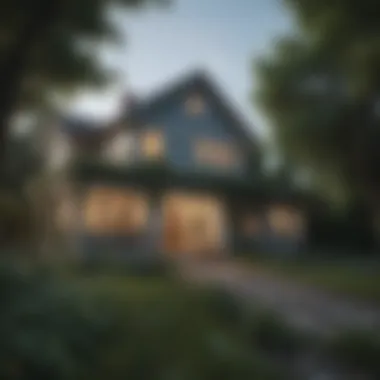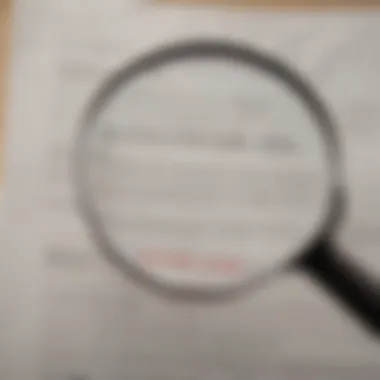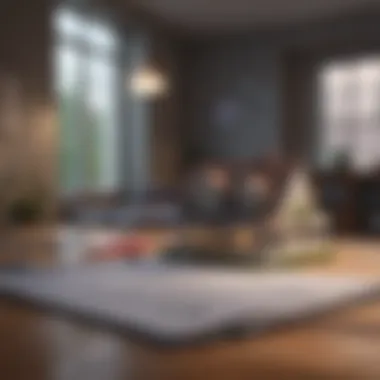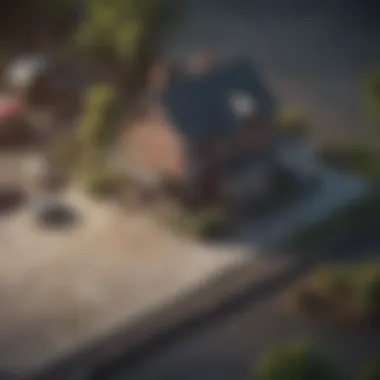Home Insurance for Unoccupied Properties Explained


Intro
When a house remains unoccupied for an extended period, the need for specialized home insurance arises. This situation often occurs for various reasons, such as relocation, travel, or even waiting for sale. Standard home insurance typically does not cover properties that are empty for more than a certain number of consecutive days. Understanding this nuance is crucial for homeowners and real estate investors to manage risks associated with unoccupied homes.
By the end of this article, you should have adequate knowledge to navigate the often complex terrain of unoccupied home insurance. This information is important for preserving the value of a property and ensuring that potential risks do not adversely affect your investment. Let's begin our exploration.
Understanding Unoccupied Properties
Understanding the nuances of unoccupied properties is critical for homeowners and investors alike. Unoccupied houses present unique risks and require proper insurance coverage to protect against unforeseen events. This section delves into what it means for a house to be unoccupied, the reasons why properties sit vacant, and the risks associated with these situations.
Definition of an Unoccupied House
An unoccupied house is defined as a property that is not currently being lived in. This may be due to various situations such as a homeowner relocating, a home being listed for sale, or properties undergoing renovations. Unlike a vacant house, which can imply that no one is present for a long period, an unoccupied house may still have occasional visits from the owner or their representatives. The precise definition can affect insurance policies, as many insurers have specific criteria for what constitutes being unoccupied.
Reasons for Leaving a House Unoccupied
There are several reasons that may lead a homeowner to leave their property unoccupied. Some common includes include:
- Relocation: A homeowner might shift for work or personal reasons, leaving their previous residence unhabited.
- Sale of Property: Individuals often leave homes vacant while trying to sell them.
- Renovations or Repairs: Homes undergoing significant renovations can be temporarily unoccupied.
- Seasonal Vacations: Some homeowners might travel for extended periods, resulting in their primary residence being unoccupied.
Understanding these common scenarios can help homeowners anticipate the risks and challenges associated with owning an unoccupied house.
Common Risks Associated with Unoccupied Properties
Unoccupied properties are susceptible to a variety of risks that can have detrimental financial impacts. Here are some notable risks:
- Theft and Vandalism: Empty houses can attract criminal activity.
- Property Damage: Without regular inspection and maintenance, issues like leaks can escalate unnoticed, leading to severe damage.
- Liability Issues: Injuries sustained on an unoccupied property can lead to legal complications for the owner.
It is essential for homeowners to understand these risks to mitigate potential losses effectively.
Addressing these concerns requires an understanding of the specific risks tied to an unoccupied property and appropriate insurance coverage. '
Types of Insurance for Unoccupied Homes
Understanding the types of insurance for unoccupied homes is critical for homeowners and investors alike. Unoccupied properties present unique risks that standard homeowner’s insurance policies often do not cover. Therefore, knowing the proper insurance options can protect your investment and give peace of mind.
Basic Homeowners Insurance
Basic homeowner's insurance often assumes that the residence is occupied. When a house is unoccupied, many policies limit coverage or have exclusions effective immediately. The key feature of this type of insurance is that it functions mainly for residences that are regularly lived in. A lack of activity can increase the likelihood of risks such as undetected damage or unauthorized entry, which may lead to significant financial loss. Consequently, homeowners should scrutinize their policies to adjust their coverage accordingly if they expect their homes to be unoccupied for a period.
Specialized Unoccupied Home Insurance Policies
This category of insurance is particularly designed for homes that will be vacant. These policies fill the gaps left by standard homeowner's insurance, providing coverage tailored to the specific risks of unoccupied homes.
Short-Term Coverage
Short-term coverage is ideal for those who anticipate a temporary vacancy in their property. This may include situations like relocating for a work assignment or extended vacations. One key characteristic of short-term coverage is its cost-effectiveness; it often offers lower premiums for short windows of unoccupancy. This type can be beneficial for lenient cash flow, as it allows homeowners to maintain some level of coverage without committing to higher costs for longer terms. However, disadvantages may include potentially higher deductibles or limited coverage options that may not fully protect against certain risks.


Long-Term Coverage
On the other hand, long-term coverage is aimed at homes that will be empty for an extended duration. This is common among investors or homeowners undergoing renovations. A prominent benefit of long-term coverage is its comprehensive nature; it usually addresses various risks that arise over extended unoccupancy. Moreover, long-term policies may include provisions for ongoing maintenance or security measures, which are crucial for unoccupied properties. However, policies catered for longer durations can be more expensive than short-term options, and navigating through exclusions might require careful reading.
Landlord Insurance for Unoccupied Properties
Landlord insurance is essential for property owners who rent out homes but may find them unoccupied occasionally. This type of policy generally provides protection against property damage while also covering liability. Importantly, these insurance plans acknowledge the unique risks associated with rental properties, including tenant turnover and vacant periods. Regular assessments of the policy is also necessary, ensuring it aligns with how often the property will be unoccupied.
Investment in the right kind of insurance is critical for anyone with unoccupied homes. Taking time to explore these options leads to better protection and fewer unwanted surprises.
Key Coverages in Unoccupied Home Insurance
Understanding the key coverages in unoccupied home insurance is essential for property owners. These coverages protect your investment from a variety of risks that may arise due to the absence of regular occupants. In the context of unoccupied houses, specific coverage components take on greater importance. This section will outline critical coverage areas, highlight their benefits, and provide considerations when selecting insurance policies.
Property Damage Protection
Property damage protection is a fundamental coverage within unoccupied home insurance. This coverage typically safeguards the structure and any interiors of the home against various perils such as fire, weather-related incidents, or vandalism. Since unoccupied properties are more susceptible to these risks, having comprehensive property damage protection is crucial.
For instance, water damage can occur when plumbing systems fail or when heavy rain causes roof leaks. Without adequate coverage, property owners may face expensive repair bills. Therefore, it is recommended to thoroughly assess the type and extent of property damage protection included in your policy. Owners should also examine the claims process, as it can considerably influence the utility of this coverage when issues arise.
Liability Coverage
Liability coverage is another critical aspect of unoccupied home insurance. It protects the homeowner from legal claims that may arise if someone gets injured on the property. Even when a house is unoccupied, it remains crucial to ensure liability coverage is adequate. Property owners can be held responsible for accidents that occur, leading to potentially significant legal fees and settlements.
Having sufficient liability coverage can offer peace of mind. It’s advisable to explore policies that provide higher liability limits. This not only covers medical expenses but also legal costs if litigation occurs. Take into consideration the neighborhood's risk factors. Higher risks associated with accidents or injuries may warrant enhanced liability coverage.
Theft and Vandalism Protection
Theft and vandalism protection covers losses resulting from burglary or malicious damage to the property. Unoccupied homes can be prime targets for thieves and vandals. As a result, it is essential to include theft and vandalism protection in your insurance policy.
This coverage helps in recovering losses from stolen items or damages done during a break-in. Policies may vary in terms of coverage limits and exclusions, so it is important to carefully read the fine print. Additionally, consider investing in security measures such as alarm systems or surveillance cameras. Some insurance providers may even offer discounts for implementing these security measures.
When securing insurance for unoccupied homes, familiarize yourself with precise definitions of theft and vandalism within your policy documentation.
Factors Affecting Insurance Premiums
Understanding the factors that influence insurance premiums is vital for homeowners with unoccupied houses. Insurance providers assess several elements to determine the cost of coverage. Knowing these factors can help in minimizing expenses while securing needed protection.
Duration of Unoccupancy
One of the primary factors affecting premiums is the duration of unoccupancy. Generally, homes that are unoccupied for longer periods face higher insurance costs. This is due to the increased risk of damage or incidents that can occur in a prolonged period without oversight. Insurers may consider homes that are empty for more than thirty days to be especially at risk.
If a home will be unoccupied for a while, seeking a specialized policy designed for longer unoccupied durations is often wise. This coverage caters specifically to the risks associated with extended periods, which may include issues like leaks or pest infestations that can go unnoticed.
Location and Neighborhood Risks
The location of the unoccupied property significantly influences insurance premiums. Insurers evaluate the neighborhood to ascertain risks such as crime rates, natural disasters, and even community maintenance. Areas with higher crime rates typically see increased premiums due to the risk of theft and vandalism.


On the other hand, properties in neighborhoods prone to natural disasters, like floods or earthquakes, also attract higher insurance costs. Homeowners should conduct thorough research to understand how location can affect their insurance rates.
Security Measures and Maintenance
Finally, the security measures taken to protect the unoccupied home can greatly impact premiums. Homes equipped with security systems, surveillance cameras, or smart technology may qualify for discounts. Insurers often see these homes as less risky, which can lead to lower premiums.
Additionally, regular maintenance of the property, like mowing the lawn or ensuring no visible signs of neglect, can prove beneficial. Such actions minimize risks and help maintain the property’s value, which insurers note positively.
Obtaining Coverage for Unoccupied Homes
Obtaining coverage for unoccupied homes is crucial for property owners. Unoccupied homes are exposed to specific risks, and a standard homeowners insurance policy may not provide adequate protection. Thus, it is essential to navigate this area carefully, ensuring that the appropriate coverage aligns with the property's unique situation and owner's needs.
Assessing Your Coverage Needs
Before purchasing an insurance policy, you must assess your coverage needs. Start by understanding the specific risks associated with your unoccupied property. Consider the following:
- Duration of Unoccupancy: How long will the house remain unoccupied?
- Location: Are there higher risks due to crime in the area?
- Current Condition: Is the house in excellent condition or does it need maintenance?
Taking these factors into consideration will help determine the right amount of coverage. It’s also wise to account for potential financial implications that could arise from damage or theft.
Comparing Insurance Quotes
Once you understand your coverage needs, it is vital to compare different insurance quotes. This process helps you find the most suitable policy. When comparing quotes, keep the following in mind:
- Policy Limitations: Ensure that the policies cover all the identified risks.
- Deductibles: Look for different deductible amounts, as they affect the overall cost.
- Exclusions: Knowing what is not covered can save you from unexpected financial burdens.
Comparing quotes from various providers can yield better insight into which policy truly meets your needs and budget.
Understanding Policy Exclusions
Familiarizing yourself with policy exclusions is imperative when dealing with unoccupied home insurance. Exclusions can vary significantly between policies. Common exclusions may include:
- Vandalism: If the property is unoccupied for too long, some insurers may not cover vandalism claims.
- Maintenance issues: Problems that arise due to lack of maintenance might not be covered.
- Natural disasters: Some policies may exclude certain risks, depending on the location of your property.
Understanding these exclusions will help you manage risks better and inform whether additional coverage is necessary to cover specific concerns.
“A well-informed property owner is better positioned to choose an insurance plan that meets their needs.”
Regulatory Considerations
Understanding the regulatory landscape surrounding unoccupied properties is vital for homeowners and investors alike. Regulations can influence insurance policies, homeowners' responsibilities, and the associated risks of maintaining unoccupied homes. Being aware of local laws provides not only peace of mind but also helps protect financial investments.
Local Laws Pertaining to Unoccupied Properties
Local legislation varies significantly between regions, influencing insurance rates and even the availability of coverage. Typically, these laws aim to address public safety, property maintenance, and neighborhood standards. For instance, many jurisdictions may require homeowners to regularly maintain their property, even if it is unoccupied. This can include lawn maintenance, clearing debris, and ensuring that the property does not become a hazard.
Consequences for not following these regulations can include fines or, in severe cases, a forced sale by local governments. Therefore, familiarizing oneself with local laws is essential. Homeowners should contact local government offices or consult legal professionals to grasp the specific requirements in their area.


Insurance Requirements Across Jurisdictions
Insurance requirements can also differ dramatically by location. Some regions mandate property insurance for unoccupied houses to ensure that necessary protections are in place.
When seeking insurance, it is important to understand:
- Coverage Limits: Different jurisdictions may have varied coverage standards, influencing how much insurance is required.
- Policy Exclusions: Certain risks might be excluded in some areas, such as specific types of damage or events like flooding.
- Documentation: Insurers may require extensive documentation about the condition of the property and its upkeep before issuing a policy.
Failing to meet local insurance requirements can lead to problems during claims or even result in legal penalties. Homeowners should ensure that they have consulted with their insurance agent to acquire the necessary coverage compliant with local jurisdiction.
Staying informed about local laws and insurance requirements can safeguard your investment and simplify the management of unoccupied properties.
Maintaining Your Unoccupied House
Maintaining an unoccupied house is critical for preserving its value and reducing risks. An unoccupied property is more vulnerable to damage from weather or other hazards. Thus, active maintenance and regular inspections can prevent small issues from becoming large problems. Keeping the house in good shape can also be essential for securing insurance coverage. Insurance companies may require proof of maintenance to honor a claim when incidents arise.
Regular Inspections and Maintenance Tips
Regular inspections help identify potential issues before they escalate. Homeowners should check for signs of roof damage, leaks, or pest infestations. A simple checklist can guide these inspections. Here are some practical tips to consider:
- Inspect the Roof: Look for missing shingles or signs of wear. Address issues quickly to prevent leaks.
- Check Gutters and Drains: Ensure they are clear of debris to prevent water damage.
- Examine HVAC Systems: If the HVAC system remains unused, schedule maintenance to avoid malfunction during occupancy.
- Monitor for Pests: Look for signs of rodents or insects, and take measures to eliminate them.
Regular maintenance tasks can include:
- Cutting grass and trimming plants to prevent overgrowth.
- Winterizing pipes to avoid freezing and potential water damage.
- Testing smoke detectors and changing batteries to ensure safety.
Implementing a consistent schedule for checks and maintenance will build good habits and keep the property in prime condition.
Security Measures to Protect Your Property
Security for an unoccupied house is a top concern for owners. A vacant home is an easy target for vandalism or theft. To mitigate these risks, consider various security measures:
- Install a Security System: Modern alarm systems with cameras can be monitored remotely.
- Secure All Entry Points: Make sure doors and windows are locked. Consider using deadbolts for extra protection.
- Use Smart Technology: Smart lights and timers can create the illusion of occupancy. Setting these to turn on at intervals can deter trespassers.
- Neighborhood Watch: Engage with neighbors to watch over the property and report any suspicious activity.
By combining careful maintenance with strategic security measures, homeowners can significantly reduce risks associated with unoccupied houses. This proactive approach not only ensures the property's safety but also supports long-term value retention.
Maintaining a home, even when unoccupied, is a commitment that protects both the property and the investment made in it.
Closure
In the realm of home insurance, understanding the coverage options for unoccupied houses is critical. This article highlights how unoccupied properties carry unique risks that deserve special attention. A tailored insurance policy mitigates these risks effectively, ensuring peace of mind for property owners, be it homeowners or investors.
Recap of Key Points
- Definition and Risks: Recognizing what qualifies as an unoccupied house is essential. Understand the potential hazards such as theft and damage that can occur during unoccupancy.
- Types of Insurance: Different types of insurance cater specifically to unoccupied homes. Basic homeowners insurance might not suffice, making specialized policies essential for full protection.
- Key Coverages: Important coverages include property damage, liability, and theft protection. Each element plays a vital role in safeguarding the asset.
- Factors Affecting Premiums: Duration, location, and security measures greatly influence insurance premiums. Homeowners must assess these variables to make informed decisions.
- Regulatory Considerations: Local laws can affect insurance requirements. Awareness of these regulations is crucial for maintaining compliance and securing adequate coverage.
The Importance of Adequate Coverage
Adequate coverage is not just a safety net but a fundamental aspect of responsible property ownership. It minimizes potential financial losses that may arise from unforeseen events. A policy designed for unoccupied properties addresses specific risks, providing tailored solutions. Moreover, understanding exclusions in policies can prevent unpleasant surprises during claims.
Investors and homeowners alike can benefit from proper coverage by protecting their investments while ensuring that they can handle losses if they occur. Risk management in real estate hinges on this adequacy of coverage, making it a pivotal consideration for anyone with unoccupied properties.
Takeaway: Securing the right insurance for unoccupied homes transforms liability into protection, turning uncertain futures into more secure ones.







